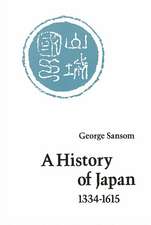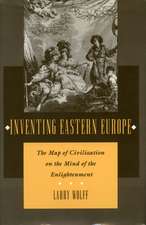Youth and Empire: Trans-Colonial Childhoods in British and French Asia
Autor David Pomfreten Limba Engleză Hardback – 15 dec 2015
By utilizing a diverse range of unpublished source materials drawn from three different continents, David M. Pomfret examines the emergence of children and childhood as a central historical force in the global history of empire in the late nineteenth and twentieth centuries. This book is unusual in its scope, extending across the two empires of Britain and France and to points of intense impact in "tropical" places where indigenous, immigrant, and foreign cultures mixed: Hong Kong, Singapore, Saigon, and Hanoi. It thereby shows how childhood was crucial to definitions of race, and thus European authority, in these parts of the world. By examining the various contradictory and overlapping meanings of childhood in colonial Asia, Pomfret is able to provide new and often surprising readings of a set of problems that continue to trouble our contemporary world.
Preț: 453.47 lei
Preț vechi: 559.85 lei
-19% Nou
86.80€ • 94.31$ • 72.96£
Carte tipărită la comandă
Livrare economică 21 aprilie-05 mai
Specificații
ISBN-10: 0804795177
Pagini: 416
Dimensiuni: 152 x 229 x 28 mm
Greutate: 0.68 kg
Editura: Stanford University Press
Colecția Stanford University Press
Recenzii
Notă biografică
Cuprins
T This introductory chapter discusses the main arguments of the book and sets out the advantages of an approach focusing upon youth and age relations to the history of empire. It describes the presence of children in non-settlement colonies and why this constitutes an important focus for research. It elaborates the current state of imperial and colonial history, the history of childhood and youth and other related fields of research and sets out how this study will apply a comparative and transnational/trans-colonial perspective in a multi-sited approach to the subject matter. It sets out the rationale for the selection of the specific interconnected sites in East and South-East Asia that form the focus of this book, explaining the comparability of these key centres of British and French colonial rule in Asia, notably Hong Kong, Hanoi, Singapore and Saigon and the nature of their inter-connectedness.
'Tropical Childhoods' argues that in the late imperial era European claims for cultural primacy came to rest firmly upon domestic norms. It shows how elite residents linked the household and the happy, healthy child within it more closely to demonstrations of social order and racial authority. At the same time this perspective clashed with interpretations of the 'tropics' as inevitably degenerative of white bodies, especially those of children. In British and French Asia children embodied the classic twentieth century problem of empire. While they could not remain, it was essential that they be there. This chapter examines variations in trans-colonial debates and different national-cultural interpretations of children and Tropical nature. It shows how experts set down different hygienic edits to manage the presence of European children in non-settlement colonies. And it shows how and why these processes were productive of profoundly gendered and qualitatively different 'colonial childhoods.'
'Cultural Contagions' looks at the 'intimate' space of the home and parents' and servants' attempts to micromanage children within it. This chapter argues that children in the colonial home were never merely passive recipients of notions of place and race. Instead, parents and children produced colonial childhood through dialogic interactions. Taking a set of encounters with disease and ill health, with non-European children and with domestic servants in four different contexts this chapter reveals how children 'spoke back' to the presumptions of vulnerability discussed in chapter 2. Drawing upon memoirs, autobiographies and letters it argues that children were active participants in cultures of mobility and inter-ethnic engagement. These shared practices exceeded the boundaries of meaning adults drew around them, and often confounded hopes that childhood would underpin racial-national hierarchies in empire.
'Magic Islands' shows how elites forged new public rituals in which children embodied and symbolised domestic norms central to imperial authority. Children offered a focus around which desires for unity, continuity, and rootedness in places where these were perpetually threatened. This case compares the case of Christmas in the Tropics and the fashioning of colonies into 'fairylands' in British empire centres with squabbles over schoolgirls in the Saigon Opera and rival visions of French and Vietnamese children in the Hanoi exposition. It does so in order to reveal how exemplary childhoods went mobile and were compared trans-colonially. And it shows how before the First World War the ambitions of elites to showcase didactic visions of national culture in empire through childhood were profoundly nuanced by local contingencies and considerations.
The Great War compromised British and French power in Asian empire centres and exposed the dangers of structuring justifications of liberal governmentalities around the unstable child subject. 'Trouble in Fairyland' shows how. It takes the case of a child monarch to illustrate the problems the French encountered as they sought real Vietnamese children to perform ideals of the docile 'associate' that were so integral to Republican political symbolism. In the years that followed, amid a rising tide of anti-colonial nationalism elites completely transformed public displays of children and childhood in British and French colonial centres. The chapter explains how new didactic presentations and representations of ideal colonial children and childhoods emerged in response to this problem in an ultimately futile effort to absorb the tensions and contradictions of empire and to broker inter-ethnic collaboration.
Globally, the management of space constituted a core tension of empire. Chapter 6 'Intimate Heights' shows how ideologies of childhood directly informed British and French colonial urban planning. To illustrate this it takes the case of campaigns to engineer hygienic spaces of 'nature' in the form of 'Hill' or 'Altitude' Stations in the early twentieth century. As Asian elites made more assertive demands upon space, Europeans' desires to self-segregate became interwoven with moral imperatives to safeguard children. In Hong Kong this dynamic produced the segregation of an entire neighbourhood in law. In French Indochina it transformed Dalat in the highlands of Annam into a 'paradise for children.' But in British Malaya, the result was a bitter conflict that stymied development in the heights. In each case, the chapter shows how children proved essential to the battles over space that defined empire in the twentieth century.
Chapter 7 shows how evidence of unfree migrant child labourers flared repeatedly from centres under British and French colonial rule, horrifying those convinced of the need to make empire 'respectable.' Reformers raised the alarm over official inaction or European complicity in the trafficking of children into statuses not easily distinguishable from slavery. They exposed Hong Kong, Singapore, Saigon and Hanoi as linked nodes in networks through which children were trafficked into unpaid migrant labour outside the family. This chapter examines the linked, trans-colonial movement of unfree children that so powerfully posed the question of European responsibility for the raising of youthful colonial subjects. It also explains why British and French engagements with this problem evolved in strikingly different directions.
'Class Reactions' brings to light the coruscating debates over social mobility sparked by the trajectories of children who went to school. Education had become a defining feature of childhood in Europe, and in Asia by the late nineteenth century colonial schooling also set new ideas and youthful bodies on the move. Young scholars' mobility triggered new social and political trajectories. Some linked this to anti-colonial ferment. Hence, while some Europeans urged the fulfilment of the colonial state's educative role others demanded clear limits to its incorporative policies. As these debates raged, youthful involvement in a rising tide of anti-colonialism triggered a series of shifts in education policy. Ultimately, increasingly desperate efforts to attenuate unrest not only divided societies but inadvertently drew together young people into new unities of age.
Chapter 9 'Raising Eurasia' shows that as Europeans used didactic visions of childhood to draw boundaries more firmly around themselves this only served to make the 'problem' of the Eurasian child more visible. The ambiguous, crisis-ridden figure of the Eurasian child formed a counterpoint to ideals of the child as a symbolically coherent, discontinuous presence. Eurasian children compromised efforts to yoke dichotomous, racialised models of childhood and youth to hierarchies of power. They raised powerful questions of imperial responsibility. Age proved critical to the quite different responses to these questions elaborated in British and French-governed centres to the end of the period.
This chapter concludes by examining the nature of the contribution made to the field. It recaps over the insights gleaned by applying the lens of age to the history of empire, and to the multi-sited approach. It provides a brief summary of the main arguments of each chapter and it elaborates a new research agenda based upon the findings of this book.














